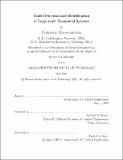| dc.contributor.advisor | Braatz, Richard D. | |
| dc.contributor.author | Chaiwatanodom, Paphonwit | |
| dc.date.accessioned | 2022-01-14T15:02:12Z | |
| dc.date.available | 2022-01-14T15:02:12Z | |
| dc.date.issued | 2021-06 | |
| dc.date.submitted | 2021-05-14T18:28:05.597Z | |
| dc.identifier.uri | https://hdl.handle.net/1721.1/139296 | |
| dc.description.abstract | A single fault in a large-scale industrial system without a proper process monitoring tool may propagate into a disastrous accident. In the field of process control, the model predictive control (MPC) is being widely applied in industry where high-quality dynamical models need to be developed for process optimization. In the fault detection and identification field, it is less common to see a model-based approach given the cost justification in developing a high-quality dynamical models, therefore most companies adopted data-based approach for process monitoring.
The main focus of this thesis in on the utilization of the MPC models along with process data for fault detection and identification in a large-scale process. The method proposed in this work allows for re-purposing of high-quality dynamical models from the MPC. In earlier work, a direct-conversion between finite step response coefficients in MPC models and a state-space model for fault detection was proposed. However, the size of the state-space model becomes very large. The model size affects the computational resources and data requirement for noise covariance estimation -- an important parameter to distinguish fault from non-fault events -- such that it becomes impractical for a large-scale industrial system.
We applied the method to both a high-fidelity process simulation and real-world datasets. We demonstrated the advantages and disadvantages of model-based fault detection over data-based methods. We also proposed the approach to combine the knowledge of model and plant data to further improve the performance of using just process model or data. We discussed challenges when apply the method to a large model and presented modifications to address those challenges.
We also explored a case study where dynamic models are impractical to develop (e.g. a non-linear and time-varying dynamic process). The anomaly detection method is proposed using process data. A high-throughput feature generation concept was applied with a newly proposed feature selection algorithm to prevent the problem with curse of dimensionality. The method was compared to the set of features selected by domain experts. The thesis shows the applicability of using process models and data for advanced process monitoring in a large-scale dynamical system. | |
| dc.publisher | Massachusetts Institute of Technology | |
| dc.rights | In Copyright - Educational Use Permitted | |
| dc.rights | Copyright MIT | |
| dc.rights.uri | http://rightsstatements.org/page/InC-EDU/1.0/ | |
| dc.title | Fault Detection and Identification of Large-scale Dynamical Systems | |
| dc.type | Thesis | |
| dc.description.degree | Ph.D. | |
| dc.contributor.department | Massachusetts Institute of Technology. Department of Chemical Engineering | |
| dc.identifier.orcid | 0000-0002-3576-4479 | |
| mit.thesis.degree | Doctoral | |
| thesis.degree.name | Doctor of Philosophy | |
